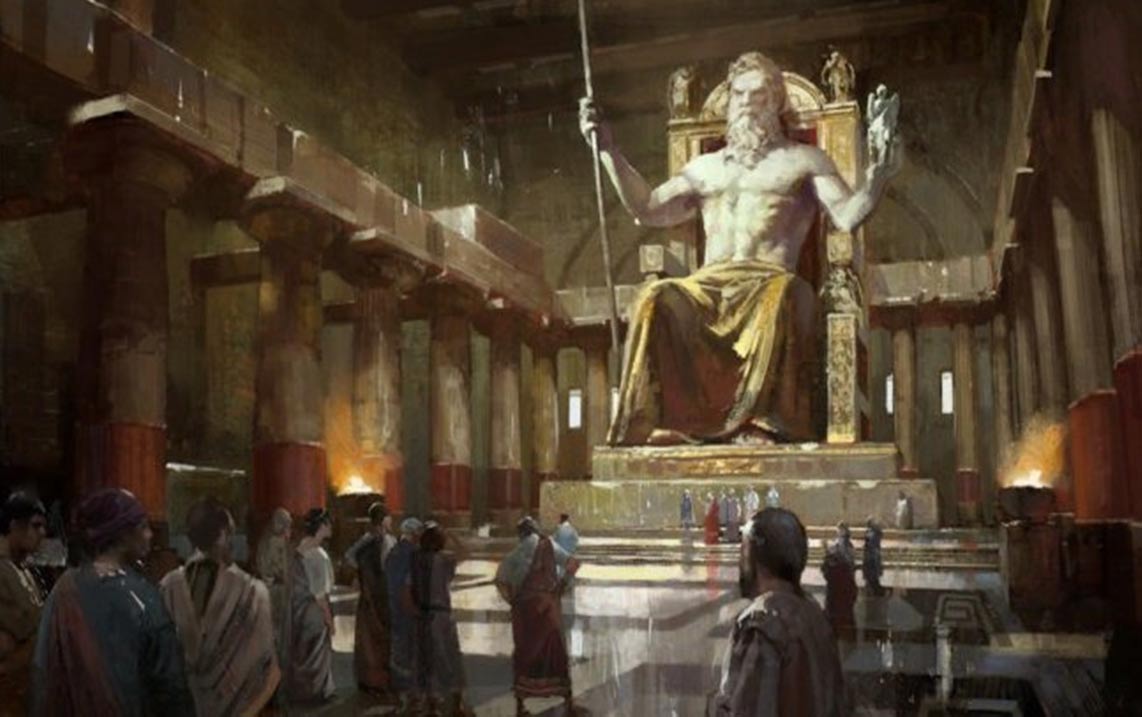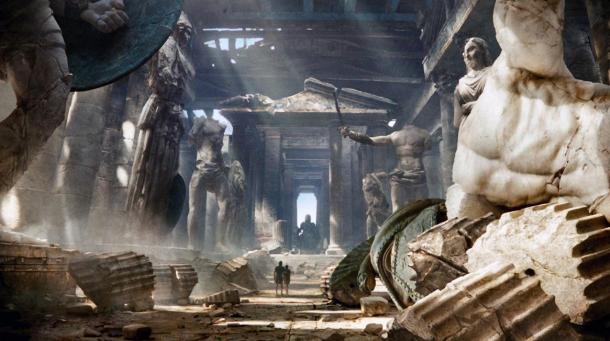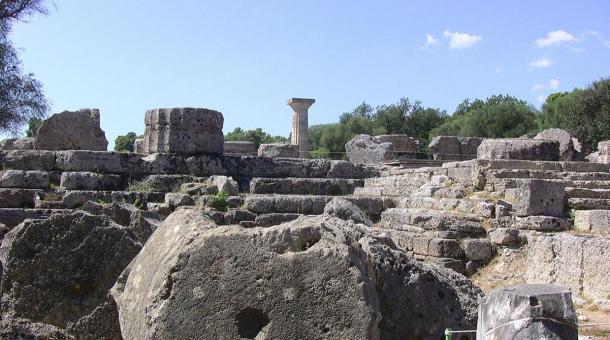Guest
Guest
 |  Subject: Wonder of the Ancient World: The Grand and Powerful Statue of Zeus Subject: Wonder of the Ancient World: The Grand and Powerful Statue of Zeus  Sat May 30, 2015 8:50 pm Sat May 30, 2015 8:50 pm | |
|  30 MAY, 2015 - 21:45 BRYAN HILLIARDWonder of the Ancient World: The Grand and Powerful Statue of ZeusThe statue of Zeus at Olympia, Greece, was one of the seven wonder of the ancient world and arguably the most famous statue of its day. Once built as a shrine to honor the Greek god Zeus, this statue was considered the incarnate of the Greeks’ most important god, and not to have seen it at least once in one's lifetime was considered a misfortune. The size of a four story building and seven times the height of an average man, it was the tallest statue of the Mediterranean world. It also remained the statue to whom the original Olympic Games were played in honor.According to legend, the altar of Zeus stood on a spot struck by a thunderbolt, which had been hurled by the god from his throne high atop Mount Olympus, where the gods assembled. Altars to Zeus graced the forecourts of houses throughout Greece and pilgrims visited his many mountaintop shrines, but the god's best-known temple was the monumental Temple of Zeus, built in a sacred grove between two rivers at Olympia on the west coast of Greece. The city of Olympia housed not only the Temple of Zeus, but also hosted the Olympic Games. They were first started in 776 BC and held every four years. One difference between the ancient and modern Olympic Games is that the ancient games were played within the context of a religious festival. They were held in honor of Zeus, considered the father of the Olympic Games. To honor Zeus, a temple was commissioned by the citizens of Olympia in 470 BC. 30 MAY, 2015 - 21:45 BRYAN HILLIARDWonder of the Ancient World: The Grand and Powerful Statue of ZeusThe statue of Zeus at Olympia, Greece, was one of the seven wonder of the ancient world and arguably the most famous statue of its day. Once built as a shrine to honor the Greek god Zeus, this statue was considered the incarnate of the Greeks’ most important god, and not to have seen it at least once in one's lifetime was considered a misfortune. The size of a four story building and seven times the height of an average man, it was the tallest statue of the Mediterranean world. It also remained the statue to whom the original Olympic Games were played in honor.According to legend, the altar of Zeus stood on a spot struck by a thunderbolt, which had been hurled by the god from his throne high atop Mount Olympus, where the gods assembled. Altars to Zeus graced the forecourts of houses throughout Greece and pilgrims visited his many mountaintop shrines, but the god's best-known temple was the monumental Temple of Zeus, built in a sacred grove between two rivers at Olympia on the west coast of Greece. The city of Olympia housed not only the Temple of Zeus, but also hosted the Olympic Games. They were first started in 776 BC and held every four years. One difference between the ancient and modern Olympic Games is that the ancient games were played within the context of a religious festival. They were held in honor of Zeus, considered the father of the Olympic Games. To honor Zeus, a temple was commissioned by the citizens of Olympia in 470 BC.
- Dikteon Cave: The Legendary Birthplace of Zeus
- The Mighty Gods Zeus & Poseidon
- Greek mythology and human origins
Crowning of Victors of the Olympic Games. Depicted at Olympia - Hiero of Syracuse and victors. (Wikimedia Commons) Between approximately 466 BC and 456 BC, the Temple of Zeus was constructed by the Greek architect Libon, according to the classical Doric style and located in the city of Olympia. In ancient times the city of Olympia was a place of the cult of Zeus and contained numerous treasures, baths, temples, monuments, altars, theaters, and beautiful statues. Pausanias, a Greek traveler who wrote the earliest guidebook to ancient Greece in 150 AD made a detailed description of the temple. The temple had 13 columns and six columns on each end of Doric style. The roof was gently peaked and 40 lion-shaped marble gargoyles on the roof served as water spouts. Under the triangles or “pediments” (the block above the columns) were sculptures depicting the twelve labors of Heracles. The temple followed a design used on many large Grecian temples and was similar to the Parthenon in Athens and the Temple of Artemis in Ephesus. Though the temple was considered one of the best examples of the Doric design because of its style and the quality of the workmanship, it was decided the temple alone was too simple to be worthy of the King of the gods. To remedy this, a statue was commissioned for the interior.The statue of Zeus was housed in the Temple of Zeus and made by The Greek sculptor Phidias in 430 BC, considered the most famous artist of ancient Greece. It took him several years to complete and was one of his two masterpieces with the other being the statue of Athena in the Parthenon.
- Ascension to the heavens in ancient mythology
- King Minos of Crete
- The Three Fates: Destiny’s Deities of Ancient Greece and Rome
The statue measured over 13m (42 feet) high and 6m (21 feet) wide and had a perimeter of 13m (43 feet). The Greek geographer Strabo noted in the first century BC that if Zeus stood up, he would have put his head through the roof of the temple. The cella or Naos, was the inner part of the temple and main room at the center of the building which contained the colossal figure. A viewing gallery allowed visitors to see it from a high vantage point which was accessed via two spiral staircases. Sitting on a throne decorated with images of heroes and gods from Greek mythology sat the immortal Zeus. The statue was made from a wooden frame of cedar wood covered with expensive materials such as ivory, ebony, bronze, gold leaf and precious stones. Zeus’s eyes were set with gemstones and around his head was a silver olive wreath. His hair and beard were made out of gold and his unclothed flesh—head, hands and feet—was rendered in burnished ivory. He wore a robe and pair of sandals made out of gold. The stool beneath his feet was upheld by two impressive gold lions. In his left hand was a scepter crowned with an eagle's head symbolizing his dominion over Earth. In his right hand sat a life-size statue of Nike, the winged goddess of victory. To keep his ivory skin from cracking the god had to be regularly anointed with olive oil, which was collected in a shallow pool beneath his feet and used to clean the statue on a daily basis. A Roman Seated Zeus, marble and bronze (restored), following the type established by Phidias and what he should have looked like at the Temple at Olympia. (Hermitage Museum, Saint Petersburg). Photo by Sanne Smit. (en.wikipedia.org) The statue of Zeus stood in place for over 800 years, and was the biggest statue the ancient Greeks ever realized. What happened to it in its later days remains a mystery. In 391 AD, Rome’s new Christian emperor Theodosius I ordered the statue dismantled and stripped of its gold. The Olympics were also abolished by the Theodosius I in 393 or 394 AD because of their pagan associations. Theodosius II ordered the destruction of the temples in 426 AD and it may have perished then or, according to historian Georgios Kedrenos, been moved to Constantinople (the new capital of the Roman empire) where it was destroyed along with the temple during a great fire in either 462 or 475 AD. The destruction of the temple of Zeus was ordered by Theodosius II in 426 AD. (picturefordesktop.com) The first archaeological work on the Olympia site was done by a group of French scientists in 1829. They were able to locate the outline of the temple and found fragments of the sculpture showing the labors of Heracles. These pieces were shipped to Paris where they are still on display today at the Louvre. The next expedition came from Germany in 1875 which was able to map the whole temple and locate the remains of the pool in the floor that contained the oil for the statue. In the 1950's an excavation uncovered the workshop of Phidias which was discovered beneath an early Christian Church. Archaeologists found sculptor's tools, a pit for casting bronze, clay molds, modeling plaster and even a portion of one of the elephant's tusks which had supplied the ivory for the statue. Many of the clay molds, which had been used to shape the gold plates, bore serial numbers which must have been used to show the place of the plates in the design. In 1958 archaeologists found a black glaze drinking cup with the engraving "I belong to Phidias."  The remains of the Temple of Zeus today at Olympia, Greece. Photo by: troy mckaskle in 2011. (Wikimedia Commons) Today, all that remains in Olympia are the temple's fallen columns and the foundation of the building, which were uncovered during 19th and 20th Century archaeological digs. Since no copies of the statue are known to exist, its exact visual representation has never been confirmed and many of the details of it are taken from depictions on coins and ancient Greek descriptions. Featured Image: The statue of a seated Zeus at Olympia, was created by the Greek sculptor Phidias. It was thirty-nine feet, or twelve meters, tall. The sculpture was wreathed with golden olive shoots and sat on a grand throne cedar wood, inlaid with ivory, gold, ebony, and precious stones. (barringtheaegis.blogspot.com)By Bryan Hilliard
Read more: http://www.ancient-origins.net/ancient-places-europe/wonder-ancient-world-grand-and-powerful-statue-zeus-003150#ixzz3bg0brjyw
|
|
Guest
Guest
 |  Subject: Re: Wonder of the Ancient World: The Grand and Powerful Statue of Zeus Subject: Re: Wonder of the Ancient World: The Grand and Powerful Statue of Zeus  Sat May 30, 2015 10:24 pm Sat May 30, 2015 10:24 pm | |
| Thanks for posting these articles ColonelZ. i get a lot out of them.
Zeus seems to be called by many names. If you just read the Greek myths he kind of sounds like an action hero. i've found him by other names in other literature and there's quite a bit of history there. He's known as Baal Hadad (or just Baal), son of Dagon (but Dagon's not his dad he just raised him), Enmerkar, Kasios, and possibly King Erechtheus/Erichthonius of Athens, which is interesting because Enmerkar was ruler of Erech/Uruk.
It gets more interesting because Kasios of the Greeks probably derives from Kasi, which tells us his heritage. The children of Kesed found a valley opposite to the land of Shinar. They built a city called Kesed, that is the land Kasdim. They were Aryans who came by way of Pakistan.
|
|





